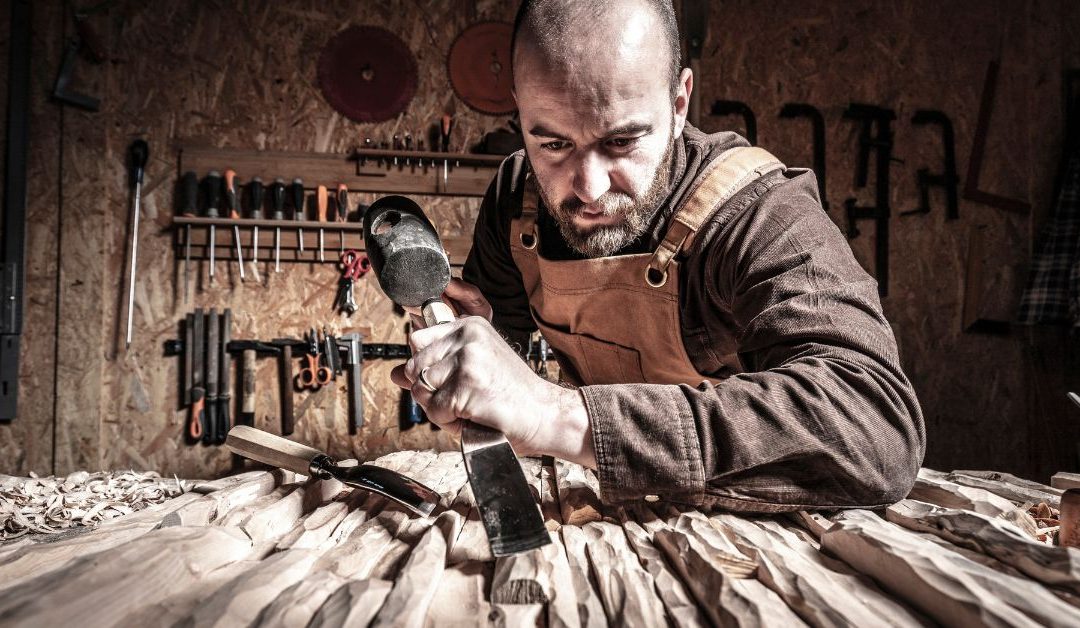Morocco is a place of vibrant culture, with many contributions to the world of artistry and craftsmanship.
Moroccan woodworkers have been famous for a long time for making amazing and useful things out of wood. They have a special talent for creating beautiful furniture and other objects using wood found in their own country. Even today, they keep making these wonderful creations, carrying on their tradition for everyone to enjoy.
In this article, we will explore the history of famous Moroccan woodworkers, as well as examine some iconic examples of their work.
We will also consider how they continue to influence contemporary craftsmen around the globe.
History Of Moroccan Woodworking
Moroccan woodworking has been a part of their culture for a very long time. It started long ago and continues today, passed down through generations. The revival of traditional Moroccan woodwork brings back the old art form and keeps the spirit of the past alive. Woodworkers in Morocco use their hands and tools to create furniture, sculptures, and instruments. They show off their creativity and skills learned from master craftsmen. This revival combines history and modernity, creating a unique style found only in Morocco. It celebrates its heritage while adding new designs and techniques. Each piece completed honors the past and brings hope for the future of Moroccan woodworking. Handcrafted pieces made with love and care are always unique in Morocco.
Traditional Woodworking Techniques
Families in Morocco have handed down the tradition of woodworking for generations. They use traditional techniques and tools that have stood the test of time for centuries. They make beautiful furniture with intricate designs inspired by stories from their region. People in Morocco hold wood carving in high regard, and you can find it showcased in homes and public places throughout the country.
Here are four techniques they use in Moroccan carpentry:
- Dovetailing: They join two pieces of wood at an angle by cutting notches that fit together.
- Inlay work: They insert thin pieces of materials like ivory or mother-of-pearl into grooves in the wood.
- Carved marquetry: They create patterns and designs using different types of wood and materials.
- Parquetry: They arrange small blocks of wood in patterns to make decorative surfaces on furniture.
These skills need patience, precision, and an eye for detail. Many generations of artisans have passed down these skills and continue to make beautiful handmade items today. This craftsmanship is an important part of Morocco’s culture and will last on to future generations.
Famous Woodworkers Of Morocco
Moroccan woodworking has a long history and is gaining renewed interest. The techniques stayed through generations, often through training programs. Woodworkers now focus on sustainability to protect natural resources.
Hassan Hajjaj is a famous Moroccan woodworker known worldwide. His unique designs combine modern materials and colors with traditional North African styles. He also teaches young people about the craft, preserving the cultural heritage. Hassan Hajjaj’s success encourages other woodworkers to mix old and new ways of doing things so that the craft can keep going for many years to come.
Through trial and error, woodworkers find their style, as Hassan Hajjaj did. His creativity shows how new ideas can bring fresh life to traditional forms. Now, let’s explore Hassan Hajjaj’s career and the impact he has had on Morocco’s rich artisanal history.
The Legacy Of Hassan Hajjaj
Hassan Hajjaj is a very well-known woodworker from Morocco. He is famous for bringing back old ways of making things out of wood and keeping the country’s culture alive. He has received many awards for his work, including the ‘Order of Merit’ from King Mohammed VI. In 2002, he opened his workshop where he creates furniture and decorative items inspired by different regions of Morocco. He also teaches others how to use modern tools while still respecting the old ways of doing things. Hassan Hajjaj is a woodworker from Morocco who loves to make things using traditional methods. He works with famous fashion brands to show off Moroccan culture to people all over the world. He creates colorful designs that mix old and new styles and celebrate different cultures.
The Work Of Mohamed Melehi
People celebrate the works of Mohamed Melehi, a famous Moroccan woodworker. Traditional Moroccan carpentry influenced his style as well as the modernist movement.
Melehi’s work often combined these two approaches, creating something new and unique. He was as well known for his intricate inlays and marquetry, which drew inspiration from Islamic geometric patterns.
Besides his woodworking, Melehi was an important teacher and mentor. He shared his knowledge and techniques with younger generations, helping them learn and grow in the craft. The works of the woodworkers he inspired will forever carry on his legacy.
Mohamed Melehi’s Works
Mohamed Melehi is a famous woodworker known for his innovative techniques and use of renewable resources. His career has spanned over 40 years, during which he has created iconic pieces in Moroccan woodworking. His work combines a modern approach with a deep appreciation for Morocco’s cultural heritage. He is famous for his creative ideas and use of safe materials in his works. He has been making beautiful wooden pieces for more than 40 years, and people all around the world love his work. Melehi combines modern techniques with a love for Morocco’s culture and traditions. He creates furniture and sculptures that show the beauty of nature.
What makes Melehi special is his commitment to the environment. He cares about using renewable resources like cedar and juniper wood, which helps protect our planet. Other craftsmen don’t always think about sustainability, but Melehi sets a good example. Future generations will always remember his amazing techniques and safe practices.
Influences
Mohamed Melehi loved Moroccan woodworking and its traditional designs inspired him. He used his knowledge of woodworking techniques to create modern and timeless furniture pieces.
He cared about the environment and used renewable materials like cedar and juniper wood in his work. This made him different from other woodworkers at the time.
Through his art, we can see how Morocco’s culture influenced Mohamed Melehi and made him famous in the art world.
Legacy
People still admire and celebrate Mohamed Melehi’s furniture pieces and craftsmanship techniques. His work showcases traditional motifs and incorporates renewable materials, inspiring woodworkers worldwide. His legacy is a lasting part of Moroccan history and contemporary art. Many people will cherish the beauty and functionality of his creations for years to come. Melehi’s ability to blend Moroccan heritage with modernity has earned him great respect in the field.
The Work Of Mohamed Chebaa
Now let’s learn about another talented woodworker named Mohamed Chebaa. He is so much praised for his skillful use of artisan techniques and unique style that combines traditional and modern elements. Chebaa makes stunning things with lots of small details. He can work on big projects like doors and windows, as well as smaller things like furniture and sculptures. Chebaa crafts each piece by hand, demonstrating his attention to detail and creativity. What sets Chebaa apart is his ability to turn ideas into tangible creations using his creative vision. He plays with color and texture to make stunning works that have gained international recognition. His art captivates people because it brings a sense of serenity and showcases Morocco’s cultural heritage. Many consider him one of the greatest living artists today. Next, we’ll explore the remarkable work of Fatima Zahra Laâbissi and discover the wonders she has created.
The Work Of Fatima Zahra Laâbissi
Fatima Zahra Laâbissi, a skilled woodworker, left a lasting impact on Morocco’s woodworking history. Laâbissi brought new ideas to old techniques and made unique designs that showed the beauty of her culture. Today, her work is much regarded and displayed in prestigious museums and galleries in Morocco.
Laâbissi specialized in crafting tableware such as trays, platters, and boxes. She made big furniture pieces like cabinets and chairs that had fancy shapes and colorful designs inspired by Islamic art.
One of her most famous creations is a carved chair called ‘The Throne of Fatima’, crafted in 1962. Her elegant style still inspires furniture makers in Morocco today. They aim to combine her timeless approach with modern techniques in their creations.
Laâbissi’s work not only affected woodworking but had a broader influence on Moroccan culture. Her designs are present in fashion, cuisine, and architecture, shaping the style and aesthetics of the country. Her legacy lives on, shaping the work of other talented artisans.
Now, let’s explore the remarkable contributions of Hassan Hajjaj and Mohamed Melehi in the world of woodworking.
The Work Of Hassan Hajjaj And Mohamed Melehi
Hassan Hajjaj and Mohamed Melehi are two famous woodworkers from Morocco who have made a big impact in their field. They have created beautiful pieces that are much loved all over the world.
Their works give us a glimpse into Moroccan culture and show off their amazing skills.
Sometimes, you can find their styles mixed, combining old and new in a perfect way.
Melehi and Hajjaj have made a lasting impact on Moroccan carpentry and will inspire future generations to carry on the tradition.
Hassan Hajjaj
Hassan’s designs are intricate and colorful, often featuring traditional symbols and objects. Mohamed’s style is unique and contemporary, with bold lines and geometric shapes.
Hassan Hajjaj’s pieces tell stories from Morocco’s past through the symbols he uses.
Mohamed Melehi
Mohamed Melehi is a talented craftsman who brings Moroccan culture to life through his unique designs. He creates beautiful pieces inspired by nature, using bold colors and patterns.
Mohamed Melehi takes a playful approach to furniture design. He creates vibrant shapes inspired by nature, adding his special touch. This brings a fun and unique look to any home.
You can find his work alongside Hassan Hajjaj’s in many homes, combining old-world style with modern expression.
Contemporary Moroccan Woodworking
The work of Hassan Hajjaj and Mohamed Melehi is famous in Moroccan woodworking history. They inspire many artists who continue their traditions.
But nowadays, woodworking has changed. People use new materials and global influences in their craft.
For example, geometric patterns are now seen in all kinds of woodwork, like screens, cabinets, tables, and chairs. Even musical instruments have these patterns!
Wood carving has changed. People used to carve by hand, but now they use machines to create intricate designs faster.
But, traditional techniques are still important. They create beautiful pieces with grace. Both old and new methods have spread Moroccan woodwork worldwide.
This distinctive style continues to thrive from a small community to global exhibitions.
The Global Influence Of Moroccan Woodwork
Moroccan woodworking has made a big impact on the world. The craftsmen from Morocco have shared their skills and knowledge with other cultures for a long time.
They use traditional tools and methods that have stayed the same over the years. This makes their work special and unique.
These talented artisans create things like doors, chests, mirrors, tables, cabinets, and decorations. They pay attention to every detail and make their pieces with care. You can find their work in small workshops and fancy stores all over the world.
Moroccan woodworking is much loved by people everywhere. Its beauty and craftsmanship continue to impress and inspire.
It is no surprise then that so many people choose these products when adding a touch of timeless elegance to any room or space.
- Unique detailed designs
- Intricate marquetry
- Precise finishing touches
- Traditional tools & methods
- Cultural Exchange & Sustainable Practices
- High-quality materials and craftsmanship.
Frequent-Asked Questions
What Types Of Wood Used In Moroccan Woodworking?
For centuries, Moroccan woodworkers are famous for their amazing skills and special ways of coloring wood.
They use materials like cedarwood and olive tree wood, which have beautiful patterns and colors when treated with local dyes.
In Morocco, some much-talented craftsmen have been practicing their techniques for many years. They create amazing pieces that people love and keep forever.
What Tools Do Traditional Moroccan Woodworkers Use In Their Craft?
Traditional Moroccan woodworkers use a variety of tools to create their beautiful pieces. They rely on hand carving to achieve intricate detailing in their artwork. Some of the common tools they use include chisels, planes, drawknives, gouges, saws, adzes, and mallets. These tools help them shape and form objects from raw lumber, allowing them to bring their artistic visions to life.
Where Can One Find Examples Of Contemporary Moroccan Woodworking?
You can find contemporary Moroccan woodworking in furniture stores, galleries, and online. Moroccan artisans have been using special techniques to finish their woodwork for a long time. They create beautiful designs using methods like marquetry and parquetry. Some craftsmen are starting to use a newer technique called steam bending. Whether you like traditional or modern styles, you can find amazing artwork made by talented woodworkers in Morocco.
How Did Moroccan Woodworking Evolve Over Time?
The techniques and wood selection process used in Moroccan woodworking has changed a lot over time. Moroccan woodworking has come a long way. People used to make furniture by hand, and now they create more complex and detailed designs. The skill of Moroccan woodworkers has improved over time, and now their craftsmanship is so recognized around the world. Many people have this beautiful style of furniture in their homes.
How Has Moroccan Woodworking Influenced Other Cultures Around The World?
Moroccan woodworking has a fascinating history that goes back a long time. Craftsmen learned their techniques from their parents and passed them on to the next generation. Many cultures have been so influenced by the way Moroccans work with wood and use different kinds of wood to make amazing and detailed designs. People all over the world find inspiration in this special style of art. They use it to create cabinets, tables, chairs, boxes, trays, and many other things.
Woodworking has been a very important part of Morocco’s culture for a very long time. From the earliest woodworkers to now, Moroccan craftsmen have made things that inspire and affect cultures all over the world.
Their legacy lives on in the tools they used, the techniques they got good at, and the amazing pieces they made with a lot of skill and art.
When we look back at this cool history, it’s obvious that Moroccan woodworking will have a big impact not only now, but for a long time to come.







